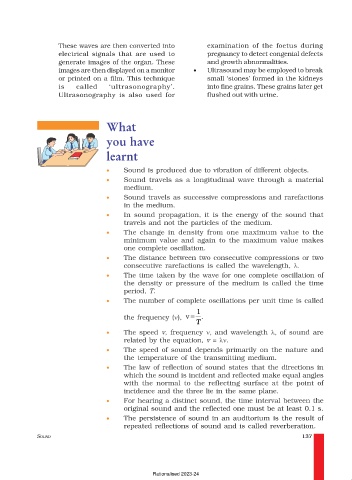Page 149 - Understanding NCERT Science 09
P. 149
These waves are then converted into examination of the foetus during
electrical signals that are used to pregnancy to detect congenial defects
generate images of the organ. These and growth abnormalities.
images are then displayed on a monitor • Ultrasound may be employed to break
or printed on a film. This technique small ‘stones’ formed in the kidneys
is called ‘ultrasonography’. into fine grains. These grains later get
Ultrasonography is also used for flushed out with urine.
What
you have
learnt
• Sound is produced due to vibration of different objects.
• Sound travels as a longitudinal wave through a material
medium.
• Sound travels as successive compressions and rarefactions
in the medium.
• In sound propagation, it is the energy of the sound that
travels and not the particles of the medium.
• The change in density from one maximum value to the
minimum value and again to the maximum value makes
one complete oscillation.
• The distance between two consecutive compressions or two
consecutive rarefactions is called the wavelength, λ.
• The time taken by the wave for one complete oscillation of
the density or pressure of the medium is called the time
period, T.
• The number of complete oscillations per unit time is called
1
the frequency (ν), v = .
T
• The speed v, frequency ν, and wavelength λ, of sound are
related by the equation, v = λν.
• The speed of sound depends primarily on the nature and
the temperature of the transmitting medium.
• The law of reflection of sound states that the directions in
which the sound is incident and reflected make equal angles
with the normal to the reflecting surface at the point of
incidence and the three lie in the same plane.
• For hearing a distinct sound, the time interval between the
original sound and the reflected one must be at least 0.1 s.
• The persistence of sound in an auditorium is the result of
repeated reflections of sound and is called reverberation.
SOUND 137
Rationalised 2023-24

